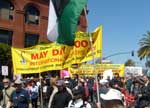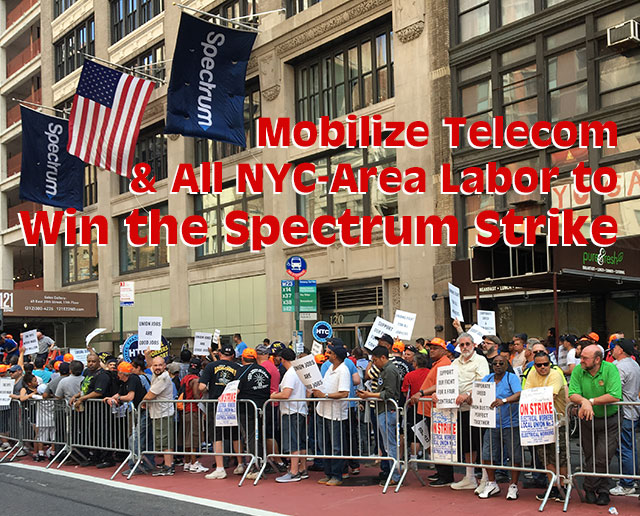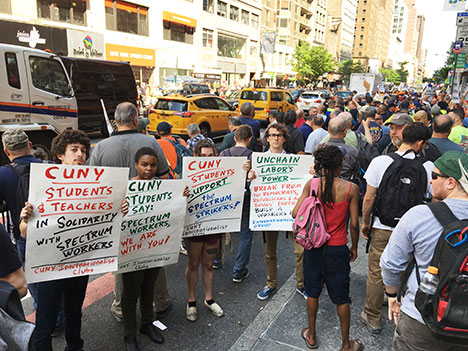
Showdown on West Coast Docks: The Battle of Longview
(November 2011).
click on photo for article

Chicago Plant Occupation Electrifies Labor
(December 2008).
click on photo for article

May Day Strike Against the War Shuts Down
U.S. West Coast Ports
(May 2008)
click on photo for article

June 2017
Enough is Enough: Stop the Scabs! Defeat the Cable Bosses!

Strike rally outside Spectrum headquarters in New York City, May 18. (Internationalist photo)
June 10 marked the 75th day of the bitter strike by 1,800 cable workers in International Brotherhood of Electrical Workers (IBEW) Local 3 against Spectrum, formerly Time Warner Cable. That’s two and a half months on the picket line, with the hardships that entails. The determination of the Spectrum workers is an example to all defenders of workers’ rights. More than that, this battle is a test for the entire labor movement. New York-area union leaders have made speeches about solidarity, while relying on empty promises by Democratic politicians. But what’s needed – and long overdue – is for the unions to use their collective muscle now to help the Spectrum workers win.
Telecommunications workers have a vital stake in this fight. There are tens of thousands of them in the NY-NJ area – their power must be mobilized in united action now, together with other key unions, to help the Spectrum strikers win. This is a case where solidarity is not just “the right thing to do” but in the immediate interest of all workers in the telecom industry. For years, the telecom bosses have played divide and conquer against the workers, using a range of tactics from manipulating technology expansion to subcontracting and naked union-busting. We saw this in last year’s Verizon phone workers strike (see “Verizon Strike: A Fight for All Workers,” The Internationalist, April 2016), in which the issue of Fios (high-speed fiber optics) expansion was closely related to competition with cable companies.
Looming in the background is Comcast, which has been called “the worst company in America” (The Verge, 19 August 2014), which is really saying something given the competition for that title. Given Comcast’s use of Walmart-style tactics to block union organizing drives, the IBEW brands it “one of the most anti-union companies in the telecommunications industry” (The Electrical Worker online, July 2011). In April 2015, Comcast’s attempt to buy Time Warner Cable was stymied by a threatened federal antitrust suit. The following month, Charter Communications bought Time Warner Cable for a cool $65 billion and changed its name to Spectrum (which makes you wonder if little Charter is some kind of stalking-horse for Comcast).
For the past four years, the Spectrum workers have been without a union contract, and now Donald Trump’s administration vows ever-bigger rollbacks of regulations to let big companies like Comcast run rampant even more than they did under his Democratic predecessors. In the face of the employers’ offensive, it’s the understatement of the year to point out that the labor movement has got to use its power – or lose it. Strikes have to be waged with a strategy to win.
This past May, with the Spectrum strike already in its fourth week, 21,000 AT&T Mobility workers struck over healthcare, sick days and other key issues. “This is the biggest strike in the United States since 40,000 Verizon workers walked out last year, and may be the biggest strike of retail workers at a national company in U.S. history,” noted the New York State AFL-CIO in a May 18 statement. Yet leaders of the Communications Workers of America (CWA) limited the strike to just three days! Instead, bringing together AT&T Mobility and Spectrum workers, and beefing up picket lines with Verizon workers and big (not just symbolic) contingents from building trades, hotel and restaurant, hospital, Teamsters and other key unions can stop the scabs, defeat the union-busters, and win this battle in the interests of the entire workers movement.
“Scabs Must Go!”
 Internationalist contingent joins with
Spectrum strikers. May 18. (Internationalist
photo)
Internationalist contingent joins with
Spectrum strikers. May 18. (Internationalist
photo)On May 18, several hundred strikers and supporters held a boisterous mass rally in front of the company’s main office on East 23rd Street in Lower Manhattan. Giving a glimpse of the enormous potential power of the NYC-area labor movement, the strikers packed both sides of the street, chanting, cheering and blowing hand-held horns. The IBEW strikers were joined by delegations from HERE (hotel and restaurant), RWDSU (retail and department store), CWA, Utility Workers and other area unions. A contingent of City University of New York students and adjuncts, organized by the CUNY Internationalist Clubs and Class Struggle Education Workers, was greeted with clenched fists by the raucous and energetic picketers, who also snapped up 40 copies of The Internationalist.
Spectrum has been raking in the profits while its workers have gone without a contract since 2013. Charter’s first moves after buying the company two years ago have been broad attacks on the workers’ healthcare, pensions and seniority rights together with a raft of other attempted take-aways (on personal days, weekend overtime pay and many other issues). In line with this, the company has taken aim at the workers’ union through increasing use of subcontractors and seeking to effectively eliminate representation by shop stewards. Local 3 members report that they have been the victims of disciplinary actions by the company as a result of customer complaints about infrastructure and services, which Spectrum refuses to update.
Spectrum strikers are fed up with the arrogant company bosses, and the several hundred scabs they’re bringing in to try to break the strike. At one point during the May 18 rally, strikers poured into the middle of the street to block traffic. Faced with a hundreds-strong rally of a union local with close to 30,000 members, the normally belligerent NYPD handled the burly street-blockers with gloves (literally), politely requesting that they move back to the sidewalk, which the strikers (joined by our contingent) took their time in doing.
Not long afterwards, an apparently disoriented scab drove down the street in a Spectrum van, which was pelted by water bottles and surrounded by angry strikers. Our comrades’ chant of “Scabs must go!” was enthusiastically picked up by the crowd, and a woman striker borrowed one of our placards to make her own sign with that slogan. Showing that their job is to “serve and protect” the capitalists’ profits and system of exploitation, the police moved in to escort the scab away. Just a few minutes later, the union tops shut down the rally.
“Partnership of Labor and Capital Is a Lie”
Being on strike this long is no joke. Spectrum workers are determined and angry, facing a company that plays hardball in its attempt to grind them into the dirt. The fact that the company can bring in several hundred strikebreakers in a union town like New York is outrageous. NYC labor can and must stop it. The presence of delegations of several key area unions at strike rallies reflects the fact that the Spectrum strike is an important battle for workers throughout the city and the country. To win it requires more than symbolic delegations and periodic mass rallies to express workers’ anger and blow off some steam – it requires bringing out the power of labor in mass pickets to stop the scabs and decisively defeat the company’s union-busting plans.
A noteworthy aspect of the Spectrum strike is the multiracial and multiethnic composition of the strikers, with a significant presence of women workers, which is something of a departure for the union. For the labor movement to beat back the decades-long offensive by the employers (which is about to escalate as court cases against public employee unions head to the Supreme Court), it is essential to bring out their power in defense of immigrants, against racist police brutality, and for the rights of us all.
This is highlighted by the stamp of approval given to Spectrum by none other than Donald Trump. Days before the Spectrum strike began on March 28, Charter Communications made the news when its CEO, Thomas Rutledge, joined Trump, the current CEO of American capitalism, for a press conference in the Oval Office. Completing this rogues’ gallery was labor- and immigrant-hating Texas governor Greg Abbott, who was brought in to tout a Charter call center opening in his state. Trump sought to take credit for a $25 billion investment that Charter had already announced last August, together with plans to close overseas call centers (Dallas News, 23 March). Meanwhile, the list of call centers being closed in Indiana, Kentucky and elsewhere in the U.S. continues to grow.
This is a vivid warning for workers not only at Spectrum but throughout the country facing viciously anti-worker employers who wrap their war on labor in the stars and stripes. The union-busting Charter CEO joining the billionaire grifter president in “America First” propaganda is a blatant example of how politicians of both bosses’ parties (and all too many labor “leaders”) try to set workers in the U.S. against those in other countries, when our real enemy is right here “at home,” on Wall Street and in Washington.
Meanwhile, the liberal Democratic version of class collaboration has been promoted by Mayor Bill de Blasio as well as Public Advocate Letitia James, who wrote a letter (signed by many city council members) calling on Charter/Spectrum to “be a good corporate actor” by providing an example of “partnership.” (James was a featured speaker at a previous Local 3 rally on April 5.) But as James P. Cannon, the founder of the Trotskyist movement in the U.S., wrote back in the 1930s: “The partnership of labor and capital is a lie.”
Cannon stressed that every strike is “a bullheaded struggle between two forces whose interests are in constant and irreconcilable conflict.... The only strike strategy that is worth a tinker’s dam is the strategy that begins with this conception. The problem of the strikers consists in estimating what their strength is, and then mobilizing it in full force and pressing against the enemy until something cracks...” (“The Maritime Strike,” November 1936). But mobilizing the full force of labor is precisely what has not happened, so far, in the Spectrum strike.
A winning strategy at Spectrum is counterposed to the labor tops’ reliance on Democratic politicians. Where this leads can be seen by what happened when subway and bus workers in Transport Workers Local 100 brought the city to a halt in 2005: then-mayor Michael Bloomberg (Republican) and state attorney general Elliot Spitzer (Democrat), backed by their respective parties, used the “slave-labor” Taylor Law to try to bust the strike, fining the workers thousands of dollars apiece and jailing the union president.
The need to unite workers in a powerful class struggle is shown by the ongoing battle to stop union-busting at B&H Photo. After an intensive organizing campaign that won union recognition for the mostly Latino immigrant workers with United Steelworkers, B&H dragged contract negotiations out for over a year, only to announce plans to close the company’s unionized Brooklyn warehouses. As we have reported, the union-busting owners have gotten a helping hand from the Democrats in City Hall (see “De Blasio Administration Complicit in Closing of B&H Warehouses,” The Internationalist, March 2017).
As the B&H workers chanted in their courageous walkout on May Day, echoing a slogan previously popularized during immigrant workers’ unionization battle at the Hot and Crusty bakery: “Jugar con reglas del patrón es segura perdición” (Play by the bosses’ rules and you’re sure to lose). To unchain the power of labor we have to free it from subservience to the bosses’ parties and politicians. Breaking from the Democrats, along with all the parties and politicians who represent a system based on the merciless drive for profit, is crucial if we are to win strikes, bust the union-busters, and defend the most basic rights and gains of the working class. ■